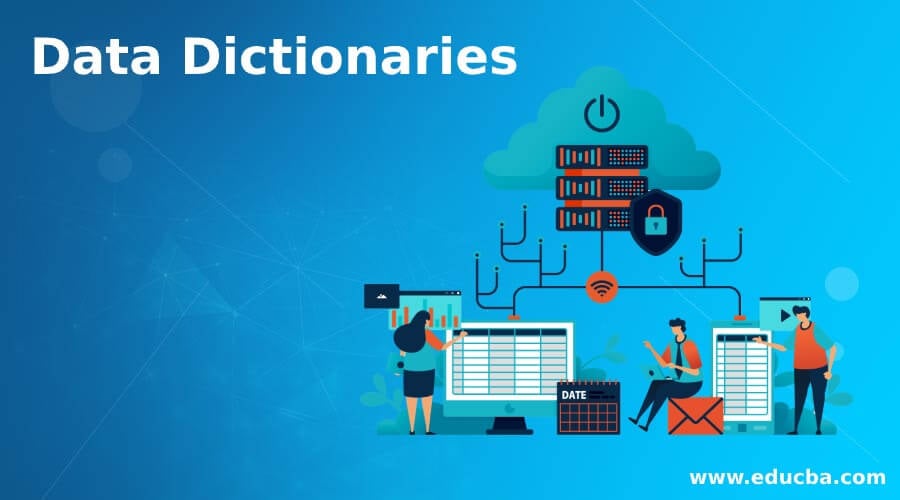Updated June 17, 2023
Introduction to Data Dictionaries
The Data Dictionary is like any other subject dictionary, which records the objects in the database. In software technology terms, we refer to these objects as “metadata.”These objects primarily are records related to data ownership, the relationship of data with other objects, and the different data structure of the objects. Now, imagine a database without information about the database itself; once made can lead you to lose the data indefinitely as we have no information about the database stored anywhere, and ironically, this creates an inevitable part of a database.
What are Data Dictionaries?
Now let us formally look into what it is and have a formal definition so that it can communicate well within the group. In this particular case, the IBM dictionary provides multiple definitions for the term, and the most accurate or suitable definition can vary depending on the context.
- A document that describes the database or its collection.
- A part of DBMS is required to determine the structure.
- A middleware that helps in extending the inbuilt data dictionary of DBMS.
It has the following information about the database, and they are:
Database table names and their schemas: As the name suggests, the table’s name, which stores the data and the schema it follows, is stored here. The schema, for example, might be the date of birth of an employee in an employee database and should have a date-type format. The dictionary stores important information about the database, including the owners of the database and their associated security constraints. It also contains details about the storage location of tables, physical characteristics of the tables, and aliases for data items. Primary key attributes, information about the foreign key, etc., constitute the table constraints. The data dictionary also stores constraints, such as the range of values; for example, the date of birth can’t be greater than today’s date. Finally, the database also stores the views, which are visible representations of the data.
Types of Data Dictionary
Now let us talk about different types of it :
1. Active Data dictionary
A huge responsibility of the database management system is to make sure that the database structure change should immediately be reflected in the data dictionary. It follows this immediate update methodology known as an active data dictionary as they are self-updating.
2. Passive data dictionary
These dictionaries are more helpful and easy to handle than active data dictionaries. Every time someone modifies the database, they need to manually update the dictionary to keep it in sync with the database. The responsibility of updating the dictionary lies with the individuals making the modifications. While it may seem counterintuitive that the database does not automatically update the dictionary, there are several advantages to using a passive data dictionary for storing metadata as a central repository. Hence, it can be used for multiple databases that are virtually the same simultaneously. Also, we can have additional metadata, which lacks an inactive data dictionary. Lastly, the job is easy when you get a friendly UI with search capability in a passive data dictionary.
Some operators are used in it, and let us look at them so that this topic is even more realistic to the working world!
- a = x + y: This means that x, y data elements are included in “a”.
- a = [x/y]: This means that either element of x or y are included in “a”.
- a = x: This means that optimal elements of x are included in “a.”
- a = b[x]: This means that b or more occurrences of elements of x are included in “a.”
- a = [x]b: This is just the opposite of the earlier, i.e., b or fewer occurrences of elements of x are included in “a.”
- a = b[x]c: This is a combination of the earlier two, i.e., b or more occurrences, and c or fewer occurrences of elements of x are included in “a.”
Uses of Data Dictionaries
Now, let us look at the uses of it in the real world and some advantages it brings along in the next few sections. This comes in handy in various instances. Users can create an ordered listing of all data items and help to create quick reports on the data hence making data management easy. It helps only authorized users to see and view the table; hence acts as a security wall.
Advantages of Data Dictionaries
Now we can easily mediate through the advantages data dictionaries brings along, so in this section, let us look at them in pointers so that this may serve as a reference in adjudging when you look forward to using a data dictionary:
- This will go a long way in understanding the data for a database administrator when he takes it over from another person.
- The building of a data dictionary is such that the provision of easy searching is available.
- Multiple programs can utilize a data dictionary for providing reporting and documentation purposes.
- It helps in maintaining data in such a way that we don’t encounter redundant data.
- It ensures that the data structure required is simplified in the process.
- The storage of metadata helps maintain high data integrity over databases.
- It comes in handy when a design process in software starts and evaluates the test cases written for testing.
Conclusion
In this article, we have learned how data dictionary is an inevitable part of DBMS and what fundamentals revolve around data dictionary. It is only the data dictionary one can refer to or consult to understand where a data item would fit in the structure of DBMS. Data item gets their real-world meaning.
Recommended Articles
This is a guide to Data Dictionaries. Here we discuss an introduction to Data Dictionaries, what it is, their different types, uses, and their respective advantages. You can also go through our other related articles to learn more –




